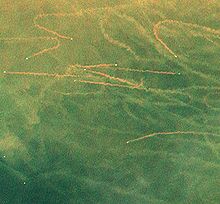Definition:
 Bottom trawling consists of towing a trawl net along the sea floor. It is a commercial fishing technique that can currently be done to more than 800m depth. Heavy nets and gear are pulled along the sea floor sweeping-up sediments and anything living there. It is a destructive, non-selective fishing method, taking anything on its pathway into the net.
Bottom trawling consists of towing a trawl net along the sea floor. It is a commercial fishing technique that can currently be done to more than 800m depth. Heavy nets and gear are pulled along the sea floor sweeping-up sediments and anything living there. It is a destructive, non-selective fishing method, taking anything on its pathway into the net.
Some facts:
Impact of bottom trawling goes beyond direct effect on biology of the sea bottom. High-energy natural processes such as tidal currents interact with the bottom morphology. These processes drive erosion, transport and deposition of sediments over wide parts of coastal shelf and continental margin. Bottom trawling links into these processes.
Bottom trawling puts fine sediments back in suspension. Then currents carry the re-suspended sediments further. Consequently, physical, morphological and chemical properties of the seabed are altered. Sediment composition is modified, so that chemical exchanges and fluxes at the sediment water interface are altered too. The sea bottom of shelf seas is modified and benthic ecosystems are damaged deeply. Down to the continental slopes, the reworking of the sea floor by trawling gradually modifies the shape of the submarine landscape over large areas, finally altering its physics and chemistry.
How trawl gear modifies the seabed in coastal seas over a wide area has been presented recently [1]. Trawling-induced sediment displacement and sediment removal from fishing grounds changes the morphology of the deep sea floor. The original bottom gets smoother as it is shown by high-resolution maps of the sea-floor relief. "...marine geologist Pere Puig and colleagues examined a shrimp fishing region off Spain’s Mediterranean coast. Puig, of Barcelona’s Institute of Marine Sciences, used remote-controlled submarines to document gouged and flattened areas along trawling routes. While undersea erosion and other natural processes cut deep valleys into the continental slope, Puig and his team noted that silt had been dumped into one of these canyons by trawling gear." [2]
Commercial fishing on a global scale by industrialised fishing fleets using bottom trawling drives evolution of the "seascape." The bottom morphology of coastal and continental seas is influenced over wide areas.
Given the global dimension of bottom trawling, the morphology of the upper continental slope in many parts of the world’s oceans has been altered by intensive bottom trawling. Effects on the sea floor thus not only destroys fish and bottom dwelling organisms, but their entire habitat. The North Sea, for example, had hard bottom with cold water corals that offered many species rich living conditions until extensive bottom trawling levelled the ground and turned it into mud flats.
As a high impact gear with modest selectivity, bottom trawls catch a lot of fish and other marine organisms which are unwanted because they are either of low or zero commercial value (too small, not the target species, damaged in the net). Depending on the type of target and how that target species mixes with others the ensuing "bycatch" can reach high percentages of the total catch.
A variation is represented by "mid-water" trawls, even bigger nets the bottom ropes of which often touch the ground and tend to catch indiscrimately what's in their way.
The Reform of the European Common Fisheries Policy (CFP) in 2013 led to a ban of bycatch discards at sea as a way to encourage low impact fishing. However, the technical difficulties and the unwillingness to comply with the regulation and land all bycatch is still leading to many "exceptions" blowing holes into the implementation of the law.
References:
[1] Puig, P. et al., 2012. Ploughing the deep sea floor. Nature doi:10.1038/nature11410
[2] from “Los Angeles Times”








